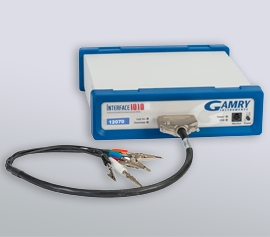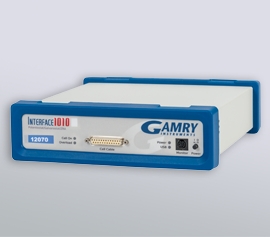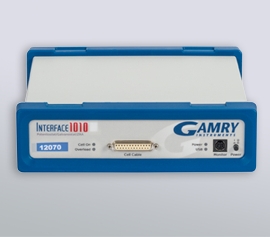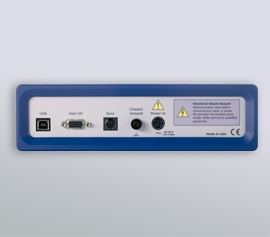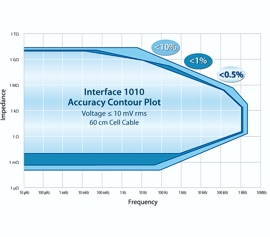Mit 9 Messbereichen und 2 Verstärkungsstufen stehen Ihnen insgesamt 11 Dekaden zur Messung von Strömen mit dem Interface 1010 zur Verfügung.
Von Korrosion bis Batterien und Sensoren bis Supercaps wird alles mit einem Maximum an Flexibilität abgedeckt. Durch modernste Mikroelektronik in Kombination mit der jahrzehntelangen Erfahrung im Design von Potentiostaten, ist der Interface 1010 ein leistungsstarkes, aber dennoch kostengünstiges Messsystem. Ob Sie Ihre kleine Batterien zyklisieren oder große Elektrodenoberflächen polarisieren möchten, der Interface 1010 bietet 1 A Strom bei ± 22 V an der Gegenelektrode. Der Interface 1010 verfügt, wie alle anderen Gamry Potentiostaten auch, über eine schwebende Masse, so dass Sie eine geerdete Arbeitselektrode oder mehrere Arbeitselektroden z. B. bei bipotentiostatischen Messungen in einem gemeinsamen Elektrolyten untersuchen können.
Außerdem kann das System dadurch problemlos mit anderen Geräten, wie z.B. AFM, QCM’s und pH-Metern eingesetzt werden, ohne dass Masseschleifen zu befürchten sind. Der Interface 1010 hat wie alle Gamry Systeme außergewöhnlich niedriges Rauschen und Brummen. Das System kann ohne zusätzliche Module oder kostenintensives Zubehör präzise Impedanz-Messungen im Bereich von 10 µHz bis 2 MHz realisieren. Der Accuracy Contour Plot (ACP) ermöglicht einen detaillierten Blick auf die Leistungsfähigkeit des Systems abhängig von den Spezifikationen der Proben. Mit dem zusätzlichen Temperaturmesseingang (Pt1000) können Sie nun außerdem die Sicherheit Ihrer Mitarbeiter im Batterielabor steigern.




